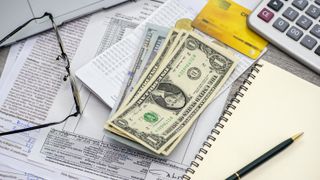When using either one of these, it is crucial that you continue to keep up with the minimum monthly payments on each of your remaining loans to avoid being stung by extra charges and higher interest rates.
Paying off the highest interest rate loan first
When considering which loans to pay off first, one option is the “debt avalanche” method. This involves putting as much extra cash as possible toward the loan with the highest interest rate, while continuing to meet the minimum monthly amount on your other loans. The biggest advantage to this method is it has the potential to save you a substantial sum in interest over the long-term. Once the most expensive loan has been paid off in full, all of the money you were putting toward it each month can then be used to start paying off the loan with the next highest interest rate. Again, you must keep up with the minimum payments on your remaining loans. You continue this process until all of your loans have been paid off. As an example, let’s say you had the three loans below:
Personal loan A of $8,000 at 10%Personal loan B of $10,000 at 12%A student loan of $5,000 at 6%
Here, you would focus on putting extra funds toward personal loan B first, then once that had been paid off, your focus would turn to personal loan A, and finally to the student loan (opens in new tab).
Paying off the smallest loan first
While paying off the most expensive debt first has many benefits, if your most expensive loan is also your biggest one, it can take a considerable amount of time to clear and it can be easy to lose motivation as a result. Many people therefore favor the “debt snowball” method. This involves paying off the smallest loan first, no matter the interest rate, and although you’ll likely end up paying out more interest overall, the results can be more tangible, giving you a bigger sense of achievement. Each time you pay off a loan, you’ll be one step closer to your financial goal of becoming debt-free and this can help keep the momentum going. Additionally, the faster you pay off your debt, the better it is for your credit score (opens in new tab) and your debt-to-income ratio. This can be particularly beneficial if you are hoping to qualify for credit such as a mortgage (opens in new tab) in the near future.
Prioritizing your loans
Regardless of which method you feel will work best for you, certain riskier loans should always be prioritized above all others. Both payday loans (opens in new tab) and title loans fall into this category as they are short-term loans that charge excessively high rates of interest. Payday loan rates can be close to 400%, while title loan rates are often around 300%. If you are unable to pay off your payday loan or title loan at the end of each month, many lenders will simply roll them over into a new loan, resulting in further fees and interest being added and starting a cycle of debt that can be difficult to escape. Those with title loans also risk losing their vehicle if they cannot repay the loan. For these reasons, paying off these riskier loans first is an absolute must. Once these have been cleared, you can turn your attention to paying off personal loan debt, alongside any credit card debt you may have. A quick and easy tactic to help pay off credit card debt (opens in new tab) is to move your balance to a 0% APR balance transfer credit card as this will allow you to avoid paying interest for a number of months. This will only work, however, if you are able to clear your credit card debt before the 0% introductory APR period ends as it is after this point that you will start paying interest at the standard rate. You will also pay a transfer fee of around 2% to 5% of the balance when you move it across and the best credit cards (opens in new tab) will only be offered to those with good credit. Loans such as student loans or home equity loans (opens in new tab) may be pushed further down the priority list as these can give you a tax break on the interest that you pay. Mortgages and business loans can also take more of a backseat as they are generally regarded as “good” debt due to their potential to make you better off in the long run.
What about debt consolidation?
If paying off loan debt feels too overwhelming and you’re concerned about managing your various repayments, you may want to consider the best debt consolidation companies (opens in new tab) as another option. These services enable you to combine all your existing loan commitments (and any other forms of credit) into a single loan with a single monthly payment. This can make the process far more manageable and saves you from assessing which debts should be paid off first. Furthermore, if you can secure a lower interest rate your monthly payments could shrink and you will save money in the long run. Alternatively, if you have already explored this option and you are struggling under the weight of your debt repayments, the best debt settlement companies (opens in new tab) may be able to help. These services negotiate with your creditors with the aim of reducing the amount you owe and hopefully establishing a repayment plan that you’re more likely to achieve. However, they should only be used as a last resort and it is wise to seek professional help first. We recommend speaking to National Debt Relief (opens in new tab) which offers a range of services to help customers manage their finances and find the right debt resolution option.
